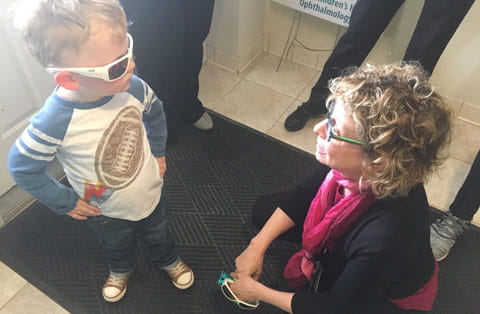Patient Stories | Meet Brock and Grayson

Grayson looks to Terry Schwartz, MD to get her opinion on several different pairs of protective sunglasses.
Seeing Better After Family Mystery Solved
Ophthalmology patients Brock and Grayson are frequent visitors to the Low Vision Clinic in Cincinnati. Their mom, Breanne, says the drive from Dayton, Ohio, is “100 percent worth it” to get the best care for her children.
A family mystery dating back over a century has been solved thanks to the team of doctors, optometrists and researchers at Cincinnati Children’s.
“We’ve been through genetics. We’ve been through everything. You’re talking over a hundred years back, and Cincinnati Children’s finally gave me a diagnosis,” said Breanne Nixon, during a recent visit to the Low Vision Clinic.
Both her sons Brock, 14, and Grayson, 3 – who suffer from impaired color vision, low visual acuity and severe light sensitivity – were born with a rare, genetic eye condition called blue cone monochromatism.
Neither wears glasses, and from physical appearances alone it’s impossible to tell there’s anything wrong with their eyes. But they are the latest in a long line of male family members with a history of impaired vision.
Support Makes a Big Difference
Today, Breanne is well-versed in the condition and is grateful for the support her boys receive.
“They’ve given us glasses. They’ve given us good advice. They’ve given us scopes. They’ve given us hope,” she said. “This [condition] has been in my family for generations and nobody has ever had a name for it – until now.”
“If you ever need help with anything, this is the place to come,” added Brock, who can’t see certain colors such as blue, pink and yellow. He has trouble distinguishing other colors like green and orange.
In Grayson’s case, he can’t tell the difference between green and orange or blue and pink. He calls most things “black” if it’s a dark color.
On this visit to clinic he needed a new pair of specially designed sunglasses which sit close to the eyebrow and cover ample space around the eyes.
“We don’t want the sun sneaking in,” said Terry Schwartz, MD, the ophthalmologist who runs the Low Vision Clinic, as she showed Grayson different glasses.
Brock doesn’t want his younger brother to repeat the same classroom struggles he’s faced, including teachers using blue markers (which he can’t read) on whiteboards.
“I just want him to know all of this stuff so he can go through school easily with no troubles. Let him know what he’s gonna need help with in the long run and what to look out for,” said Brock, who is entering high school. It’s a big transition for any student, let alone someone with a rare vision disorder that can be difficult to explain to teachers.
Someone in Their Corner
The good news – “great” according to Breanne – is that Brock is not alone. The Low Vision Clinic has been fighting for and advocating for patients like Brock and Grayson since it's inception.
When Brock first came to the clinic, his school vision services had been removed, including his teacher for the visually impaired. The program director at the time was vigilant in getting the services restored. She attended Brock's IEP [Individualized Education Program] meeting with Breanne and fought to get vision services back.
"It's been a huge support," Breanne. "To have the support and the documentation when you walk into a classroom, is power itself. You can’t just walk in and explain it yourself and have it make sense. So when you have that report that Dr. Schwartz writes up, it’s like gold.”
For the most part, Brock relies on assisted technology within the classroom. Teachers can share their projected screens via apps to Brock’s laptop and smart tablet. He also takes pictures with the tablet and can expand the images and manually adjust the background settings as needed for visual clarity and to read and complete assignments.
His favorite subject is science, he said, because it’s more hands-on. Outside the classroom, he plays basketball and swims and enjoys watching videos on YouTube about exotic cars and cool shoes.
“I do everything that every other kid can do just fine. I can catch stuff fine. Everything like that,” he said.
And like most teenagers he’s not sure what he wants to do in terms of a career, but he’s already thinking of the future.
“I want to go for sports medicine or something of that nature. It seems fun. I don’t know. Welding seems kind of cool, too, but I don’t know about that. I’d probably burn myself if I did that,” he said.
Grayson is too busy looking up to his older brother to think about the future.
“He’s the best!” said Grayson, leaving the clinic.
(Published: August 2019)



